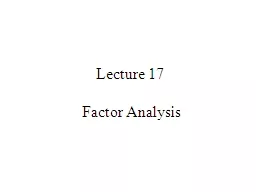

Factor Analysis Syllabus Lecture 01 Describing Inverse Problems Lecture 02 Probability and Measurement Error Part 1 Lecture 03 Probability and Measurement Error Part 2 Lecture 04 The L 2 ID: 329830
Download Presentation The PPT/PDF document "Lecture 17" is the property of its rightful owner. Permission is granted to download and print the materials on this web site for personal, non-commercial use only, and to display it on your personal computer provided you do not modify the materials and that you retain all copyright notices contained in the materials. By downloading content from our website, you accept the terms of this agreement.
Slide1
Lecture 17
Factor AnalysisSlide2
Syllabus
Lecture 01 Describing Inverse Problems
Lecture 02 Probability and Measurement Error, Part 1
Lecture 03 Probability and Measurement Error, Part 2
Lecture 04 The L
2
Norm and Simple Least Squares
Lecture 05 A Priori Information and Weighted Least Squared
Lecture 06 Resolution and Generalized Inverses
Lecture 07 Backus-Gilbert Inverse and the Trade Off of Resolution and Variance
Lecture 08 The Principle of Maximum Likelihood
Lecture 09 Inexact Theories
Lecture 10
Nonuniqueness
and Localized Averages
Lecture 11 Vector Spaces and Singular Value Decomposition
Lecture 12 Equality and Inequality Constraints
Lecture 13 L
1
, L
∞
Norm Problems and Linear Programming
Lecture 14 Nonlinear Problems: Grid and Monte Carlo Searches
Lecture 15 Nonlinear Problems: Newton’s Method
Lecture 16 Nonlinear Problems: Simulated Annealing and Bootstrap Confidence Intervals
Lecture 17 Factor Analysis
Lecture 18
Varimax
Factors,
Empircal
Orthogonal Functions
Lecture 19 Backus-Gilbert Theory for Continuous Problems; Radon’s Problem
Lecture 20 Linear Operators and Their
Adjoints
Lecture 21
Fr
é
chet
Derivatives
Lecture 22 Exemplary Inverse Problems, incl. Filter Design
Lecture 23 Exemplary Inverse Problems, incl. Earthquake Location
Lecture 24 Exemplary Inverse Problems, incl.
Vibrational
ProblemsSlide3
Purpose of the Lecture
Introduce Factor Analysis
Work through an exampleSlide4
Part 1
Factor AnalysisSlide5
source A
ocean
sediment
source B
s
4
s
2
s
3
s
1Slide6
sample matrix
S
S
arranged row-wise
but we’ll use a column vector
s
(i) for individual samples)Slide7
theory
samples are a linear mixture of sources
S
=
C FSlide8
theory
samples are a linear mixture of sources
S
=
C F
samples contain “elements”Slide9
theory
samples are a linear mixture of sources
S
=
C F
sources called “factors” factors contain “elements”Slide10
factor matrix
F
F
arranged row-wise
but we’ll use a column vector
f
(i) for individual factorsSlide11
theory
samples are a linear mixture of sources
S
=
C F
coefficients
called “loadings” Slide12
loading matrix
CSlide13
inverse problem
given
S
find
C
and
Fso that S=CFSlide14
very non-unique
given
T
with inverse
T
-1
if S=CFthen S=[C T-1][TF] =C’F’Slide15
very non-unique
so a priori information needed to select a solutionSlide16
simplicity
what is the minimum number of factors
needed
call that number
pSlide17
does
S
span the full space of
M
elements?
or just a
p –dimensional subspace?Slide18
E
3
E
2
s
1
s3ABs1s4E1Slide19
we know how to answer this question
p
is the number of non-zero singular valuesSlide20
E
3
E
2
E
1
s2s3ABs1s4v2v1v3Slide21
SVD identifies a subspace
but the SVD factors
f
(
i
)
= v(i) i=1, pnot uniqueusually not the “best”Slide22
factor
f
(1)
v
with the largest singular value
usually near the mean sample
sample mean <s>minimizeeigenvector <v>minimizeSlide23
factor
f
(1)
v
with the largest singular value
usually near the mean sample
sample mean <s>minimizeeigenvector <v>minimizeabout the same if samples are clusteredSlide24
s
3
f
(
1)
s
1s4f(1)f(2)f(2)s4s3s2s2s1E3E2E1E3E2E1(A)(B)Slide25
[U, LAMBDA, V] =
svd
(S,0);
lambda =
diag
(LAMBDA);
F = V';C = U*LAMBDA;in MatLabSlide26
[U, LAMBDA, V] =
svd
(S,0);
lambda =
diag
(LAMBDA);
F = V';C = U*LAMBDA;“economy” calculationLAMBDA is M⨉Min MatLabSlide27
since samples have measurement noise
probably no exactly singular values
just very small ones
so pick
p
for which
S≈CFis an adequate approximationSlide28
Atlantic Rock Dataset
51.97 1.25 14.28 11.57 7.02 11.67 2.12 0.07
50.21 1.46 16.41 10.39 7.46 11.27 2.94 0.07
50.08 1.93 15.6 11.62 7.66 10.69 2.92 0.34
51.04 1.35 16.4 9.69 7.29 10.82 2.65 0.13
52.29 0.74 15.06 8.97 8.14 13.19 1.81 0.04
49.18 1.69 13.95 12.11 7.26 12.33 2 0.1550.82 1.59 14.21 12.85 6.61 11.25 2.16 0.1649.85 1.54 14.07 12.24 6.95 11.31 2.17 0.1550.87 1.52 14.38 12.38 6.69 11.28 2.11 0.17(several thousand more rows)SiO2 TiO2 Al2O3 FeOt MgO CaO Na2O K2OSlide29
Al
2
0
3
Ti0
2
Al203Si02K20Fe0Mg0Al203A)B)C)D)Slide30
singular values,
λ
i
index,
iSlide31
f
(5)
f
(2)
f
(3)
f(4)SiO2TiO2Al2O3FeOtotalMgOCaONa2OK2OSlide32
C
2
C
3
C
4